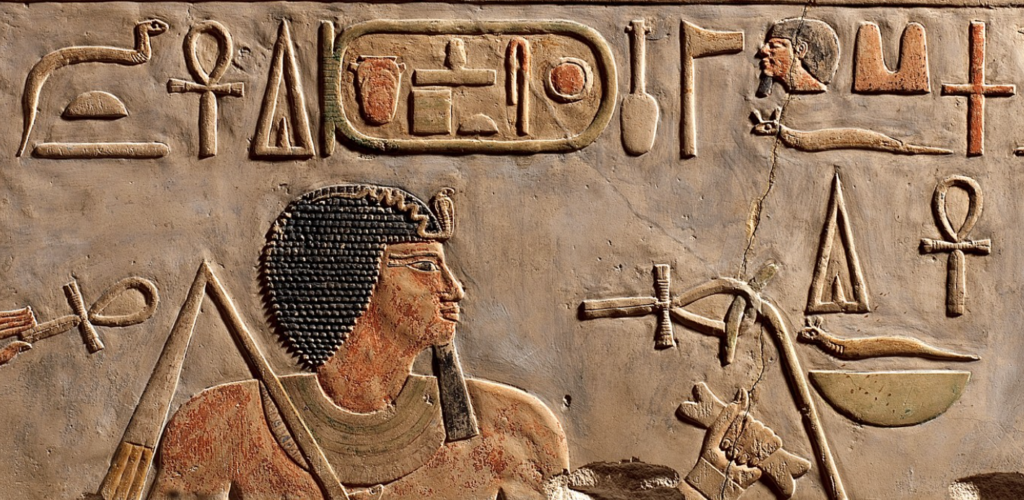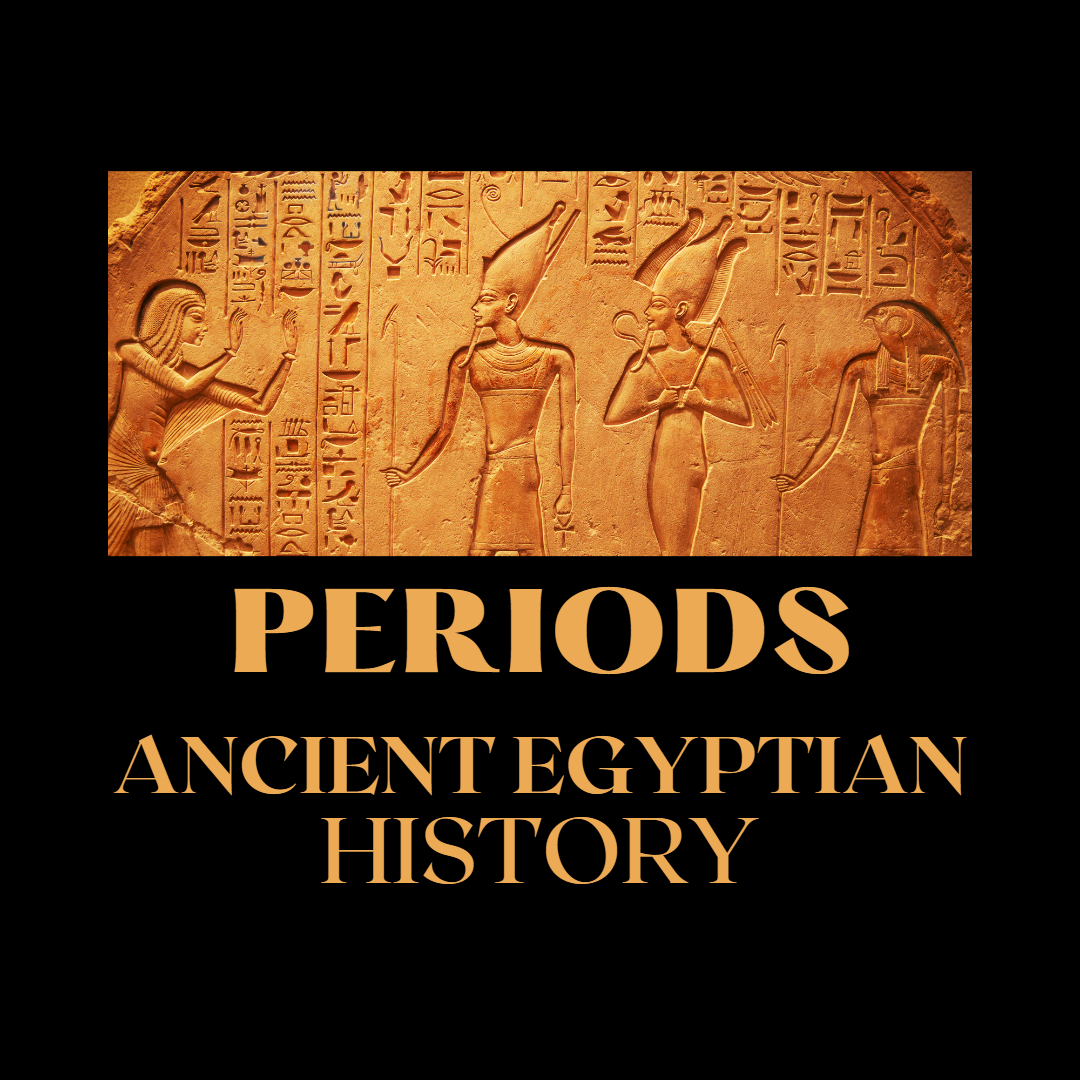
Prehistoric Period 5500-3100 BCE
- Garden of Eden 4026
Early Dynastic Period 3100-2680 BCE
- Noah and the Flood 2348 BCE
Old Kingdom 2650-2175 BCE
First Intermediate Period 2175-1975 BCE
- Abraham was born in 2055
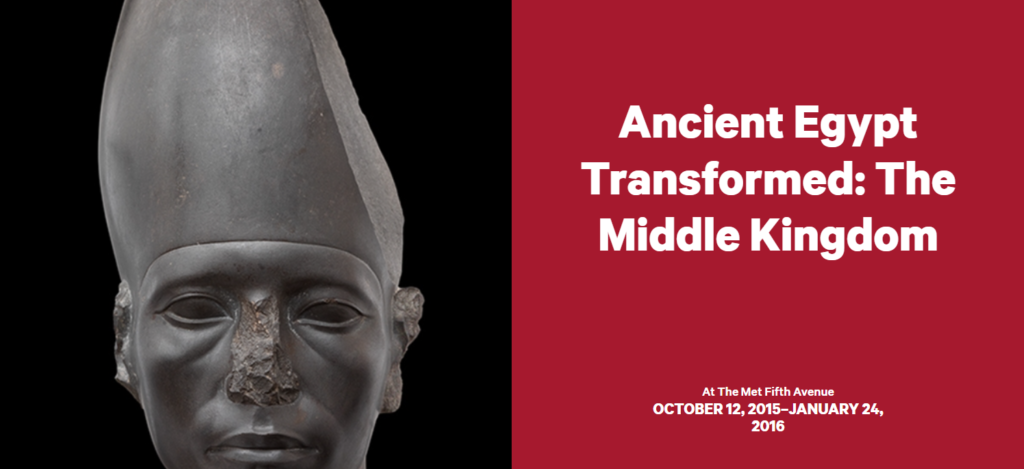
“The reunification of ancient Egypt achieved by Nebhepetre Mentuhotep II—the first pharaoh of the Middle Kingdom—was followed by a great cultural flowering that lasted nearly four hundred years. During the Middle Kingdom (mid-Dynasty 11–Dynasty 13, around 2030–1650 B.C.), artistic, cultural, religious, and political traditions first conceived and instituted during the Old Kingdom were revived and reimagined.” The Met
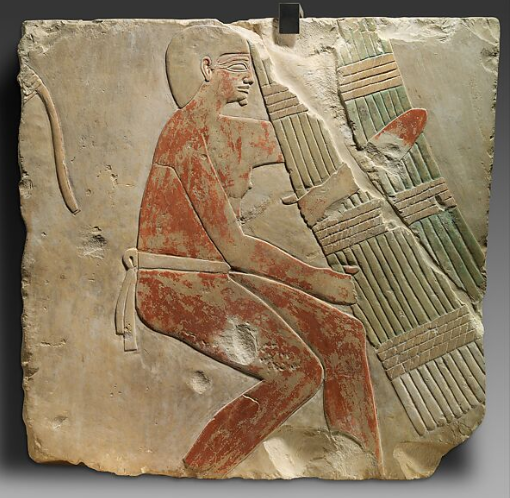
Relief of a Man Carrying a Papyrus Bundle Middle Kingdom
Loan Not on view
This object is not part of The Met collection. It was in the Museum for a special exhibition and has been returned to the lender.
“This relief depicts a worker struggling to lift a huge bundle of green papyrus stalks. The complete scene would have shown the construction of papyrus boats, a type of watercraft commonly used for fishing and fowling in the marshes. The dynamism with which the fleeting movement of an ordinary worker is depicted sharply contrasts with the more static representations of kings and deities, who were posed for eternity.” The Met
Relief of Nebhepetre Mentuhotep II and the Goddess Hathor
“King Nebhepetre Mentuhotep II was revered by the Egyptians as the ruler who reunited Egypt after the era of disunity (the First Intermediate Period) that followed the end of the Old Kingdom. Descended from a family of Theban rulers, the king built his tomb and mortuary temple at Deir el-Bahri in western Thebes. This relief was originally part of the decoration of the temple’s main sanctuary that was added to the building at the end of the king’s reign. The fine balance between figures and inscriptions on this block, as well as the clear outline and regular proportions of the king’s image with its individualized facial features, exemplify the peak of a relief art that had developed over the decades while the vast temple complex was built and decorated. The figure of the goddess Hathor on the right of the block was chiselled away during the Amarna period, when King Akhenaten propagated the sole worship of the god Aten. Hathor was repaired in plaster in early Dynasty 19 and some of the paint on the whole block may also have been renewed at the time.” The Met
Statue of King Nebhepetre Mentuhotep II in the Jubliee Garment
“Twenty-two statues of this type stood beside (but not in the shadow of) sycomore and tamarisk trees that lined the processional path through the forecourt of the mortuary temple of Nebhepetre Mentuhotep II at Deir el-Bahri. The rough, rectangular base was inserted into the ground. The king wears the traditional short mantle of the pharaoh’s thirty-year jubilee festival (Heb Sed). In his fists were the now missing scepter and flail of Egyptian kings and the god Osiris, probably made of metal. The head on this piece wears the “red” crown of Lower Egypt. Although no head with the “white” crown of Upper Egypt was found, it is conceivable that the statues along the south side of the path wore the “white” Upper Egyptian crown, while the ones along the north side wore the “red” Lower Egyptian one. At some later time all statues from the forecourt were decapitated and broken up. Some bodies were buried close to their original places, others were moved around. Most of the heads are missing. Both the body and head of the Museum’s statue were found in the area of the temple of Hatshepsut, which is adjacent to the Mentuhotep temple. It is not certain that the head really belonged to this particular body.
“The style of the statue is intentionally archaic, presumably because Mentuhotep II was commemorated as the ruler who reunified the country after the First Intermediate Period, thus restoring Egypt to its original state as first created during the late Predynastic and early Dynastic Period.” The Met
Lintel of Amenemhat I and Deities
Middle Kingdom 1975-1755 BCE
Second Intermediate Period 1755-1540 BCE
New Kingdom 1540-1075 BCE
- Joseph’s Story took place about 1500 BCE
- Moses’s Story took place about 1450 BCE
_____________________________________
Prehistoric Period of Ancient Egypt 5500-3100 BCE
The Importance of the Nile River in Egypt’s History

Image Credit Ancient Egypt DK Pocket Genius

Map of the Nile
Image Credit Ancient Egypt DK Findout!
“The Nile valley of Egypt was basically uninhabitable until the work of clearing and irrigating the land along the banks was started.[4] However, it appears that this clearance and irrigation was largely under way by the 6th millennium. By that time, Nile society was already engaged in organized agriculture and the construction of large buildings.[5]
“At this time, Egyptians in the southwestern corner of Egypt were herding cattle and also constructing large buildings. Mortar was in use by the 4th millennium. The people of the valley and the Nile Delta were self-sufficient and were raising barley and emmer, an early variety of wheat, and stored it in pits lined with reed mats.[6] They raised cattle, goats and pigs and they wove linen and baskets.[6] Prehistory continues through this time, variously held to begin with the Amratian culture.
“Between 5500 BC and the 31st century BC, small settlements flourished along the Nile, whose delta empties into the Mediterranean Sea.” Wikipedia
References
- ^ Barich, Barbara E. (1998). People, Water, and Grain: The Beginnings of Domestication in the Sahara and the Nile Valley. l’Erma di Bretschneider. ISBN 978-88-8265-017-9.
- ^ Gatto, Maria C. “The Nubian Pastoral Culture as Link between Egypt and Africa: A View from the Archaeological Record”.
- ^ Barbara E. Barich et al. (1984) “Ecological and Cultural Relevance of the Recent New Radiocabon dates from Libyan Sahara”, in Lech Krzyżaniak and Michał Kobusiewicz [eds.], Origin and Early Development of Food-Producing Cultures in Northeastern Africa, Poznań, Poznań Archaeological Museum, pp. 411–17.
- ^ Carl Roebuck, The World of Ancient Times (Charles Schribner’s Sons Publishing: New York, 1966) p. 51.
- ^ Redford, Donald B. Egypt, Canaan, and Israel in Ancient Times. (Princeton: University Press, 1992), p. 6.
- ^ Jump up to:a b Carl Roebuck, The World of Ancient Times, p. 52.
_____________________________

Image Credit Ancient Egypt DK Pocket Genius

Image Credit Ancient Egypt DK Pocket Genius

Image Credit Ancient Egypt DK Pocket Genius

Image Credit Ancient Egypt DK Pocket Genius
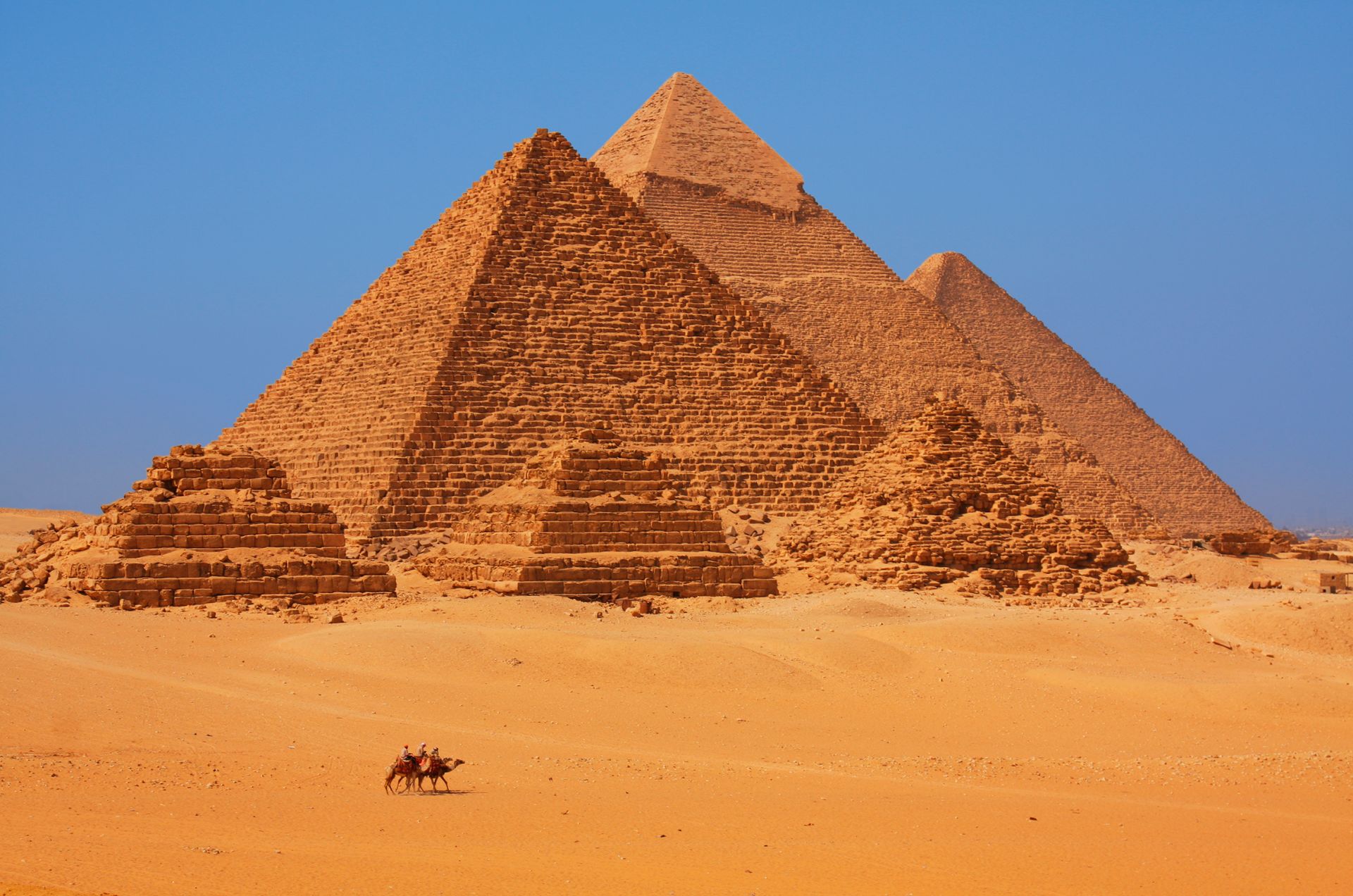
Image Credit Ancient Egypt DK Findout!
Old Kingdom 2650-2175 BCE
“The Old Kingdom is most commonly regarded as spanning the period of time when Egypt was ruled by the Third Dynasty through to the Sixth Dynasty (2686–2181 BCE). The royal capital of Egypt during this period was located at Memphis, where Djoser (2630–2611 BCE) established his court.
“The Old Kingdom is perhaps best known, however, for the large number of pyramids, which were constructed at this time as pharaonic burial places. For this reason, this epoch is frequently referred to as “the Age of the Pyramids.” The first notable pharaoh of the Old Kingdom was Djoser of the Third Dynasty, who ordered the construction of the first pyramid, the Pyramid of Djoser, in Memphis’ necropolis of Saqqara.
“It was in this era that formerly independent states became nomes (districts) ruled solely by the pharaoh. Former local rulers were forced to assume the role of nomarch (governor) or work as tax collectors. Egyptians in this era worshiped the pharaoh as a god, believing that he ensured the annual flooding of the Nile that was necessary for their crops.
“The Old Kingdom and its royal power reached their zenith under the Fourth Dynasty. Sneferu, the dynasty’s founder, is believed to have commissioned at least three pyramids; while his son and successor Khufu (Greek Cheops) erected the Great Pyramid of Giza, Sneferu had more stone and brick moved than any other pharaoh. Khufu, his son Khafre (Greek Chephren), and his grandson Menkaure (Greek Mycerinus) all achieved lasting fame in the construction of the Giza pyramid complex.” Wikipedia

Image Credit Ancient Egypt DK Pocket Genius
The Fifth Dynasty -2495 – The sun god Ra

Image Credit Ancient Egypt DK Pocket Genius
“The Fifth Dynasty began with Userkaf c. 2495 BC and was marked by the growing importance of the cult of the sun god Ra. Consequently, less effort was devoted to the construction of pyramid complexes than during the Fourth Dynasty and more to the construction of sun temples in Abusir. The decoration of pyramid complexes grew more elaborate during the dynasty and its last king, Unas, was the first to have the Pyramid Texts inscribed in his pyramid.” Wikipedia
Citations
DK. “DKfindout! Ancient Egypt.” Dkbooks, www.dk.com/us/book/9781465457530-dkfindout-ancient-egypt.
DK. “Pocket Genius: Ancient Egypt.” Dkbooks, www.dk.com/us/book/9780756698133-pkt-geniusancient-egypt.
Wikipedia
_______________________________________
Ancient Egyptian Timeline Relative to Bible History
“The Babylonian Nebuchadnezzar’s capture of Jerusalem in his eighth year (2 Kings 24:12) can be dated precisely to 16 March 597 b.c. The Assyrian Shalmaneser III’s contacts with Kings Ahab and Jehu can be dated 853 and 841 b.c. respectively; and, while neither contact is mentioned in the Bible, the fact that between Ahab and Jehu appear two other kings that occupy exactly twelve years proves that 853 must have been the last year of Ahab and 841 the first of Jehu. Counting backward from these dates, one establishes Solomon’s death and the division of the kingdom in 930 b.c. and the Exodus in 1446 b.c. (1 Kings 6:1). Among the more significant of the OT’s absolute dates are these:
. . .
” Adam would then, theoretically, date from 10,000 b.c. or earlier; but, since Seth was prob. not born in the immediate year of Adam’s death, man’s creation may perhaps be dated 15,000 b.c., or c. a millennium before the famous Lascaux cave paintings….”
“… the birth of Abraham in 2166 b.c….
“Specific correlations of Abraham with secular chronology have not been established. The patriarch did have dealings with an unnamed Egyp. pharaoh (Genesis 12:10-20) shortly after his entrance into Canaan in 2091 b.c., presumably a minor ruler of the 10th Dynasty before its fall to the contemporaneous Dynasty XI of Thebes in the S. Shortly thereafter occurred the raid upon Pal. (ch. 14) by Amraphel and his allied monarchs from Elam and Babylonia.
[In the Hebrew Bible, Amraphel …was a king of Shinar (Hebrew for Sumer) in Book of Genesis Chapter 14, who invaded Canaan along with other kings under the leadership of Chedorlaomer, king of Elam.” Wikipedia
“…Esau’s fortieth birthday in 1966 b.c.(Gen 26:34) …
Jacob was Joseph’s Father. He was also called Israel. Stories about Jacob begin in the Bible in Genesis 25:19.
“Joseph. The unnamed pharaoh who elevated Joseph in 1885 would have preceded the great Sesostris III, the seventh year of whose thirty-eight year reign “can be pinpointed [by astronomical data] with great probability to 1872 b.c.” (CAH rev., p. 12). The Egyp. tone of Joseph’s record confirms this date at the peak of the Middle Kingdom (Dynasty XII) rather than one later, in the period of foreign (Hyksos) invasion that followed….
Abraham’s birth – 2166 b.c.
Abraham’s Entrance into Canaan – 2091 b.c.
Jacob’s return to Canaan in 1909 (Gen 35:9-12)
Jacob’s Descent 1843 b.c. – Jacob was also called Israel. He was Joseph’s father.
“A. Israel’s descent. The MT of Exodus 12:40 sets the duration of Israel’s stay in Egypt at 430 years. Hence, if the Exodus is dated at 1446 b.c. (see B, below), the descent would be dated 1876; and Abraham’s entrance into Canaan would have to be placed 215 years before that (130 years for Jacob, plus 60 more for Isaac, plus 25 more for Abraham prior to Isaac’s birth) at 2091 b.c., and his birth at 2166. The LXX of Exodus 12:40, however, reads, “The time that the sons of Israel dwelt in the land of Egypt and in the land of Canaan (was) 430 years,” which is supported by the Samar., and hence may have been the original wording. If so, this would mean that since Jacob (Israel) and his sons had been in Pal. for thirty-three years before their removal to Egypt (between Joseph’s sixth and thirty-ninth birthdays, Gen 31:41), this then would leave 397 recorded years for the actual Egyp. sojourn and dates the descent in 1843 b.c., as proposed above in I and II. This latter figure seems better to suit Scripture’s rounded references to the Egyp. period. In Genesis 15:13 and Acts 7:6 the “four hundred years” is closer to 397 than to 430, and esp. in Acts 13:19 ASV the phrase, “about four hundred and fifty years,” is closer to 443 (the 397, plus 40 years in the wilderness, plus 6 years for the conquest up to the division of Canaan, Acts 13:18, 19) than to 476, which would have suggested, “about five hundred.” These references also oppose the reconstruction of Ussher, who followed a variant LXX reading which extended the 430 years of Exodus 12:40 to include the dwelling in Egypt and Canaan of the sons of Israel, “they and their fathers.” Ussher, following this latter reading began his counting with Abraham’s first entrance into Canaan, leaving only 215 for the Egyp. sojourn. He was prob. influenced by Galatians 3:17 ASV, which speaks of the law at Sinai (soon after the Exodus) coming 430 years after the promise of “a covenant confirmed by God.” Since this last v. may refer to God’s confirmation of the covenant promise to Jacob at his return to Canaan in 1909 (Gen 35:9-12) rather than to its initial Abrahamic revelation in 2091, it should not be invoked in opposition to the uniform testimony of Genesis 15:13; Acts 7:6; and 13:19 to Israel’s four centuries in Egypt (cf. M. Kline, WTJ, 27 (1964), 7). This much time seems also to be required for Israel’s increase from one household to several million people (Exod 12:37; cf. KD, II:28-30), for the 8,600 known male descendants of Levi’s son Kohath at the time of the Exodus (Num 3:28), and for the ten generations that grew up in Egypt (1 Chron 7:25-27).
“B. Israel in Egypt At what point in history did Egypt begin its systematic oppression of Israel? The pharaoh “who knew not Joseph” (Exod 1:8) is not named. That he might have been Aahmes I, the founder in 1570 of Dynasty XVIII and of the New Empire, is suggested by this ruler’s hatred of the foreign (and Sem.) Hyksos, whom he expelled in 1567 (cf. 1:9, 10). That the oppressive pharaoh might have been the first of these same Hyksos, who occupied the E Delta from c. 1730 on, would be favored by the ruthlessness of these conquerors toward those in Egypt, by their location at Avaris (near Pithom and Raamses, 1:11), and by the lengthy oppression that Scripture suggests (cf. Gen 15:13, and J. Rea, ETSB, 3 [1960], 60, 61) combined with their known founding of a temple at Avaris in 1720 b.c. (CAH rev., pp. 13, 14).
The Exodus from Egypt 1446 b.c.
“The whole preceding chronology of the OT depends upon the date that one assigns to the Exodus. Its season was in the first month of spring (Exod 12:17, 41), after Moses’ return to Egypt during the Nile inundation of the preceding summer (7:24; 8:6). Scripture states further that Solomon’s Temple was founded during April/May “in the 480th year after the [Exodus]…in the 4th year of Solomon’s reign” (1 Kings 6:1). This latter year began in the fall of 967, so that a counting back of 479 years would produce the date of … 1446 b.c.”
….
“The older identification of Rameses II (1304-1237) as the pharaoh of the oppression and of his son Merneptah (1237-1225) as the pharaoh of the Exodus has now been generally abandoned….
” In any event, the Biblical date of 1446 b.c. accords well with the death of the famous conqueror Thutmose III, whose reign is assigned to 1504-1450 by means of astronomy (CAH rev., pp. 17, 18) and whose building projects near Goshen and use of Sem. slaves is well-documented (SOTI, pp. 215-219). The pharaoh of the Exodus would thus have been his son and successor, Amenhotep II, while Moses’ early protector and royal benefactress may have been Thutmose’s equally famous aunt, regent, Hatshepsut, as indicated below:
The pharaoh who used slaves to build near Goshen may have been Thutmose.
In any event, the Biblical date of 1446 b.c. [date of the Exodus] accords well with the death of the famous conqueror Thutmose III, whose reign is assigned to 1504-1450
Princess who saved Moses may have been Hatshepsut – the aunt of the preceding ruler Thutmose.
Amenhotep II may have been the pharaoh of the Exodus. He was Thutmose’s son.
V. Wilderness. Israel remained in the wilderness forty years, but only thirty-eight years were actually spent in the “wanderings” (Deut 2:14), commencing after “the time of the first ripe grapes” (Num 13:20), in 1445 b.c.:
Moses’ sending out of the spies (in 1445 b.c.
Hitt. empire in the N. Israel’s oppression from 1382-1374 b.c.
the accession of Rameses II in 1304 b.c.
Birth of David
David’s accession over all Israel (2 Sam 2:10, 11) in 1003 b.c
Absalom’s Revolt – 979 b.c.
David’s Death – 970 b.c.
C. Solomon. Shortly before his death in 970 b.c. David ordered his son Solomon anointed over the united kingdom (1 Kings 1; 1 Chron 23:1). While Solomon’s coregency appears to have been brief, if it was counted at all (P. van der Meer, The Ancient Chronology of Western Asia and Egypt, p. 72), it yet established a significant precedent in Judah; for Jehoshaphat, Jehoram, Azariah, Jotham, and Ahaz were to be granted coregencies with their fathers, and apparently for the same reason: to guarantee their succession and to insure the throne’s stability, in contrast to the kaleidoscopic history of N Israel, where only one such instance appears. Solomon’s chief foreign contacts were his building arrangements with Hiram king of Tyre (Ahiram I, 986-935 b.c.) and his marriage to an Egyptian princess (1 Kings 3:1; 9:16), perhaps a daughter of Siamun, the last pharaoh but one of the 21st Dynasty, which terminated in 945 b.c.
division of Solomon’s kingdom in 930 b.c.
Source:
Chronology of the Old Testament – Encyclopedia of the Bible – Bible Gateway. www.biblegateway.com/resources/encyclopedia-of-the-bible/Chronology-Old-Testament.


